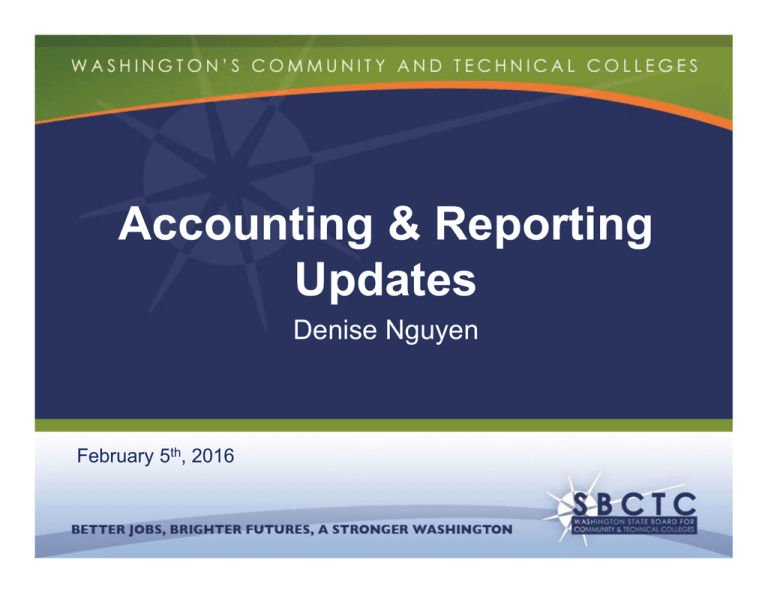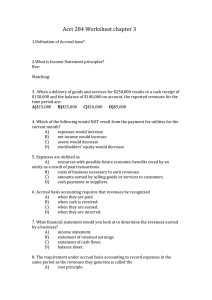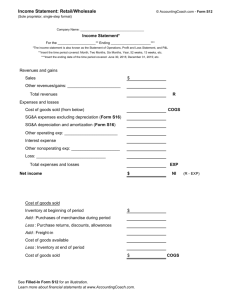Accounting & Reporting Updates Denise Nguyen February 5
advertisement

Accounting & Reporting Updates Denise Nguyen February 5th, 2016 Reminders: • Monthly error reports • COPs – we will work with each college that has them • Federal reporting Reconcile reimbursed grant revenues to expenditures Document explanations for any variances Verify your coding: the first two CFDA digits should agree with the last two digits of your source code Example: CFDA # 84.xxx Revenue Source Code should be 0384 2 SAO recommendations Table of Contents and Order of Presentation • Display of Independent Auditor’s Report before the Management Discussion and Analysis • Arrangement of Foundation Statements –the order should be as follows: College’s Statement of Net Position Foundation’s Statement of Net Position/Balance Sheet College’s Statement of Revenues, Expenses and Changes in Net Position Foundation’s Statement of Revenues, Expenses and Changes in Net Position/Income Statement College’s Statement of Cash Flows 3 SAO recommendations Management Discussion and Analysis • • • • • • Condensed Financial Data (Comparative) – This should include the following: Total assets (distinguishing between capital assets and other assets) Total liabilities (distinguishing between long-term liabilities and other liabilities) Total net position/equity (distinguishing; net investment in capital assets; restricted net position; and unrestricted net position) Operating revenues (by major source) Nonoperating revenues (by major source) Operating expenses and nonoperating expenses (as presented in the statement of revenues, expenses and changes in net position/equity) Excess or deficiency (before any contributions to term and permanent endowments, special items, extraordinary items and transfers) Contributions Special and extraordinary items Transfers Change in Net Position Ending Net Position Analysis of government’s overall position and results of operations – Additionally, this is where the College should address whether their overall financial position has increased or decreased. A description of significant capital asset and long-term debt activity – The discussion should refer the readers to the specific related note number in the financial statements. Discussion of currently known facts, decisions or conditions of future significance Refraining from addressing topics not specifically prescribed under GASB – (i.e. Statement of Cash Flows breakdown) Analysis portion of the MD&A: explain/disclose significant changes (i.e. why did capital assets increased) 4 SAO recommendations Statement of Net Position • Restricted Cash line Move student loan fund balance from 9590 to 9560 (from unrestricted to restricted expendable) The 3.5% in fund 860 portion should be moved to 9531 to reclassify it as restricted expendable. The total of these two should show as an adjustment under Restricted Cash and cash equivalents. • Capital assets that are not being depreciated (such as land or infrastructure assets) should be reported separately from those that are being depreciated if the College has a significant amount of these assets 5 SAO recommendations Statement of Revenues, Expenses and Changes in Net Position • Operating vs. Non-operating Grants: Disclose in the summary of significant accounting policies • Combining them into one section [“Nonoperating Revenues (Expenses)] • Please change the “Income or (loss) before other revenues, expenses, gains or losses” to “Income before capital contributions” 6 SAO recommendations Ensure that amounts across the statements that should tie/reconcile together: • Net Position on the Statement of Net Position = Net Position on the Statement of Revenues, Expenses and Changes in Net Position • Ending cash and cash equivalents on the Statement of Cash Flows = Cash and Cash equivalents on the Statement of Net Position • Operating income (for the reconciliation of Statement of Cash Flows) on the SCF = Operating income on the Statement of Revenues, Expenses and Changes in Net Position • Capital contributions/appropriations on the SREC = Capital contributions + Noncash capital received on the Statement of Cash Flows. • Any display on the face of the financial statements should be tied to the Notes to the F/S 7 SAO recommendations Notes to the Financial Statements • Note 1 – New Accounting Pronouncements There is no need to disclose GASB statements adopted in the past. Avoid negative disclosures for the Notes to the F/S (example: GASB 69 – Government Combinations and Disposals of Government Operations and state that it does not apply to the College). • Schedule of Long-Term Debt - The schedule should include all long-term liabilities. We often found that compensated absences (and other noncurrent liability items found on the Statement of Net Position) were not included in this schedule on the Notes to the Financial Statements. • Component unit disclosures – the Notes to the College’s financial statements should include: a brief description of the component units and their relationships to the primary government. a discussion of the criteria for including the component units in the financial reporting entity and how the component units are reported. information about how the separate financial statements for individual component units may be obtained. • There have been a few colleges that excluded component unit information in their financial statements altogether. 8 SAO recommendations Additional • Foundations An annual GAAP audit of the foundations statements is required to obtain an unmodified opinion on the College’s Opinion Unit of the Foundation. • Notes for Foundations Review the Foundation notes and add in any disclosures that they feel are significant transactions with the primary government or important enough that a reader would want to know. • Links to audited financial statements 9 Template updates • Include net changes for fund 999 compensated absences • Entries from GASB 68 calculations • Present the fees remitted to State Treasurer and State Board on the cash flow statement and the operating statement • Removed “capital revenues” • Question: Should we present our statements comparatively? We do not recommend comparative presentation at this time. 10 Audit updates: • All colleges have received their FY15 financial statement template • Template for the Notes and MD&A will be shared with the colleges shortly • Audit timeliness: we encourage you to have each year’s financial statement audit done within 12 months after the close of that year • A glaring issue: Deficiencies in internal controls over financial reporting • Risk assessments 11 GASB 68 reporting • DRS prepared the Participating Employer Financial Information (PEFI): shows the proportionate share percentage for each college. • OSA: calculated the estimated net pension liability (NPL) • OFM: calculated the state portion for the CAFR • SBCTC: calculated the proportionate share for each college for the financial statements. These calculations do not go in to AFRS 12 Required calculations: • Net Pension Liability • Pension Expense • Deferred outflows: of resources represent a consumption of fund equity that will be reported as an outflow of resources (expenditure/expense) in a future period. • Deferred inflows: of resources represent an acquisition of fund equity that will be recognized as an inflow of resources (revenue) in a future period. In governmental fund type accounts, a deferred inflow of resources is reported when revenues do not meet the available recognition criteria. 13 FYI – • We participated in PRS 1/2/3 and TRS 1/2/3 • None of these plans have assets • PRS 1 and TRS 1 are underfunded. Other plans contribute to these plans to fulfill the underfunded portion • PRS 1 and TRS 1 do not have an amortization schedule. Any increase/decrease in the proportionate share will be expensed or reduce the liability, respectively. • Only PRS 2/3 and TRS 2/3 are required to amortize any increase/decrease in the proportionate share. • All calculations used the Actuary’s numbers to be consistent. OFM chose to use this method as the difference between the Actuary’s numbers and the actual are immaterial. • Calculations are for FY14 (a year behind). Activity in FY15 will be classified as deferred inflow/outflow. • Our accounting system does not have the GLs needed for GASB 68. All entries are done and tracked manually for future use 14 GASB 68 calculations: • Obtain college’s proportionate share from the PEFI • Enter the % share into template to calculate all the required amounts • Complete T accounts for each account • Total and summarize to present on the financial statements 15 Supporting documents: • PRS 1 (UAAL - Unfunded Accrued Actuarial Liability) • PRS 2 & 3 with amortization schedule • TRS 1 (UAAL) • TRS 2 & 3 with amortization schedule • Summary sheet 16 • Financial Statement Workgroup: Any comments or feedback? Do we want to have a get together a day before the next BAR? 17




